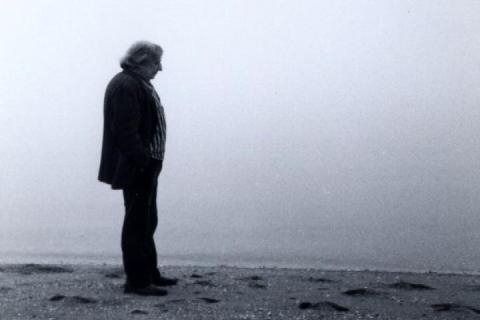
The contrasting comfort and horror of losing your memory, to know and not know at once, is the inherent reality of Alzheimer’s Disease. If you are to experience it, you are afforded the relief in allowing yourself to forget your weaknesses, faults, and mistakes, but that is paired against the absolute threat of not knowing the person before you in the mirror, next to you at your house, or staring at you from a collection of photos on your mantel. I can’t imagine the reality of that, what the experience could be like, what I might feel or say to someone I once knew and know no more. That is, I couldn’t imagine it before watching Alan Berliner’s First Cousin Once Removed.
The filmic image is itself a storehouse of memory, and much of Berliner’s body of work is steeped in the investigation of the memories that we build in a life time; he is known for exploring that which is personal to him. This film is perhaps the apex of such a practice. In this instance, with his new film First Cousin Once Removed, Berliner has the opportunity to explore the life of his relative, lauded poet, translator, and professor, Edwin Honig, during his struggle with Alzheimer’s disease. If you wonder how one man could so diligently and excruciatingly film another, whether or not the subject is aware of the situation and the man behind the camera, you will be happy to know that this film is the result of Honig’s own suggestion. Honig was aware of the reality that he would not only lose his memory, but inevitably himself as well, and approached his cousin to ask him to make this film. Berliner was to Honig a great artist, one of the few members of his own family that he held respect for. This respect, quite obviously, is mutual.
The use of editing sets up the non-chronological format of the film in the opening scene. Over several visits, Berliner films the same shot of his arrival to Honig’s home, and edits them together to produce a shot of himself walking from point a to point b, sourced from many days over the years he spent to make the project. In doing so he gives us the true language of the film, which is the construction of the image from a mind in the process of deconstructing and the effect is both practical and haunting. On several occasions Berliner arrives and has to explain to Honig who he is and why there is a camera. On more than one occasion, Honig is not comfortable with the explanation. The situation of entering and explaining echoes and loops and gives a strong sense of a poetic disorientation.
I find the real beauty in this film is to witness the reality of disintegration within a poetic exploration. We watch as a poet who is losing his language begins to rattle of a mess of syllables which resemble a dadaist chant. There is a musicality involved, perhaps a way of passing time in the brain, even if the brain is failing at the jobs it once performed with such ease. Scenes in which Berliner describes pieces of Honig’s life back to Honig, who seems shocked to hear, for example, of his having been knighted by two countries for his work, you can witness a real feeling of bearing witness to one’s self with purity, as though you are a stranger. When shown a video of himself reading poetry to an audience, he doesn’t see himself, but rather, ‘a man who is trying to be very important’ and laughs at him, somehow seeing its futility without placing the relevance. The fact that his work is incredibly important to others escapes him.
The filmic landscape does what it can to work within the situation it is recording. The sound of a typewriter marks the time, and after one of Honig’s particularly lucid musings, the typewriter chimes, having arrived at the end of its line. We visit the many stories and opinions of the man who used to exist, including those of failed relationships with his adopted children and his ex wife, and protective statements from his sister, but none are so adept at handling the impressions of that man that is. Sadly, Honig died sometime towards the end of shooting and we are left with an empty chair and three words, in order. Chair, tree, bird. Do your best to remember them in order. It will mean something to you by the time the film’s credits are rolling.






